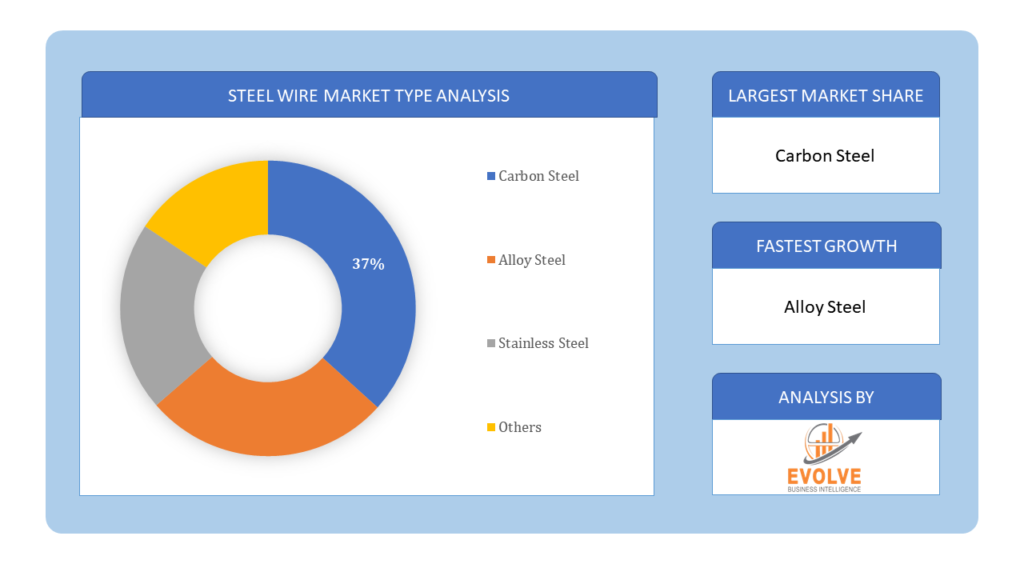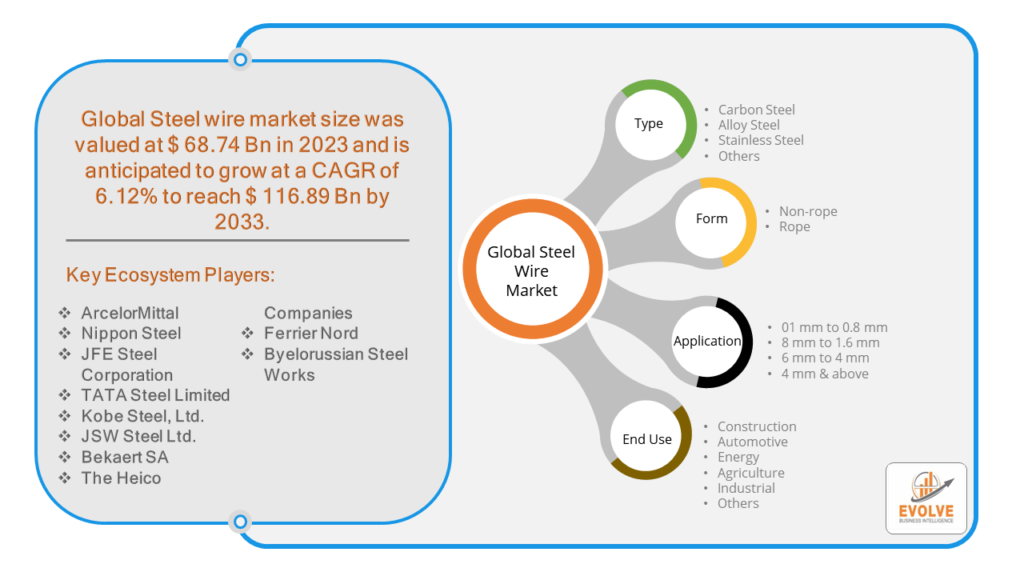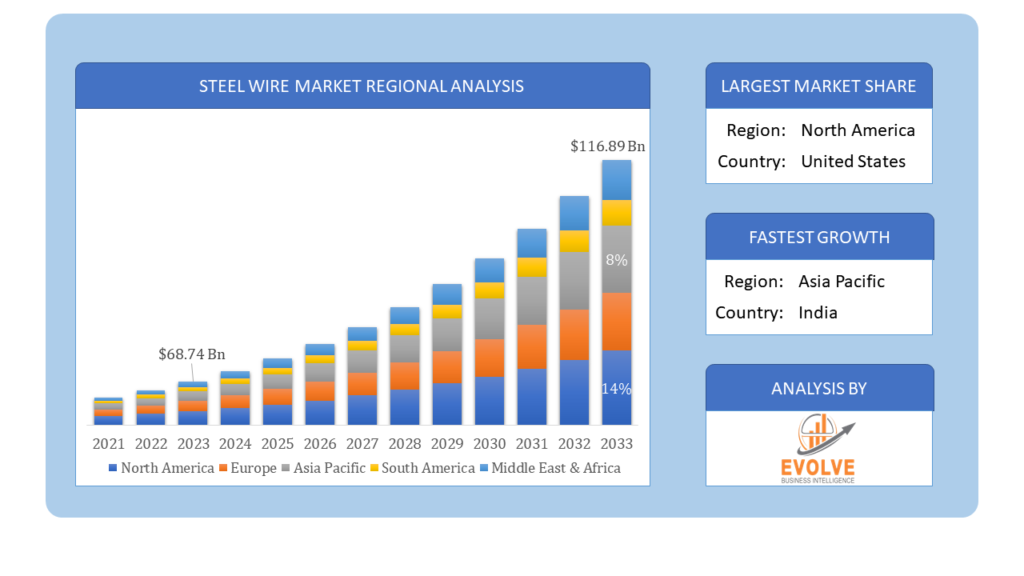Steel wire Market Overview
Steel wire Market Size is expected to reach USD 116.89 Billion by 2033. The Steel wire industry size accounted for USD 68.74 Billion in 2023 and is expected to expand at a compound annual growth rate (CAGR) of 6.12% from 2023 to 2033. The steel wire market refers to the production, distribution, and application of various types of steel wire used in industries such as construction, automotive, manufacturing, and aerospace. The market is driven by the versatile applications of steel wire and the growth of these industries. Factors such as increasing urbanization, infrastructure development, and the expansion of the automotive industry contribute significantly to the market’s growth. The market is highly competitive, with key players investing in research and development to stay ahead. The market is segmented by form, type, and end-use industry. Steel wire is used in various applications, including construction, automotive, manufacturing, and aerospace, with construction being the key application segment. The market is expected to grow at a compound annual growth rate of 4.7% from 2022 to 2030.
Global Steel wire Market Synopsis
The Steel wire market experienced a detrimental effect due to the Covid-19 pandemic. The COVID-19 epidemic has caused supply chain hiccups that have resulted in shortages or decreased demand for steel wire. Spending by consumers and businesses has decreased significantly as a result of the travel restrictions and social distancing measures, and this trend is expected to persist for some time. The epidemic has altered end-user trends and tastes, prompting manufacturers, developers, and service providers to implement diverse tactics aimed at stabilizing their businesses.
Global Steel wire Market Dynamics
The major factors that have impacted the growth of Steel wire are as follows:
Drivers:
⮚ Technological Advancements
Advances in steel manufacturing technologies, such as improved alloys and production processes, can enhance the quality and performance of steel wire, making it more appealing for various applications and driving long-term demand.
Restraint:
- Shifts in Consumer Preferences and Technological Advancements
Opportunity:
⮚ E-commerce and Logistics
The growth of e-commerce and the logistics industry creates demand for packaging materials, storage solutions, and transportation infrastructure, all of which rely on steel wire products. As online shopping continues to expand globally, there is a growing need for durable and reliable steel wire for pallets, shelving, and material handling equipment.
Steel wire Market Segment Overview
By Type
 Based on the Type, the market is segmented based on Carbon Steel, Alloy Steel, Stainless Steel, Others. With a revenue share of more than 64.0%, carbon steel led the global market in 2021, and it is expected that this trend would hold true for the duration of the forecast. Wires are made from both low- and high-carbon steel and are mostly utilized in the construction, automotive, and military industries.
Based on the Type, the market is segmented based on Carbon Steel, Alloy Steel, Stainless Steel, Others. With a revenue share of more than 64.0%, carbon steel led the global market in 2021, and it is expected that this trend would hold true for the duration of the forecast. Wires are made from both low- and high-carbon steel and are mostly utilized in the construction, automotive, and military industries.
By Form
Based on Form, the market has been divided into Non-rope, Rope. the Non-rope segment includes wire forms utilized in various industrial applications such as fencing, welding electrodes, and automotive components. Meanwhile, the Rope segment encompasses wire forms primarily employed in construction, marine, and utility sectors for their tensile strength and durability in rope manufacturing
By Application
Based on the Application, the market has been divided into 0.01 mm to 0.8 mm, 0.8 mm to 1.6 mm, 1.6 mm to 4 mm, 4 mm & above. he 0.01 mm to 0.8 mm segment caters to intricate applications like electronics and medical devices due to its fine diameter. The 0.8 mm to 1.6 mm segment serves diverse industries including construction and automotive for medium-duty applications like reinforcement and fastening. The 1.6 mm to 4 mm segment is vital in heavy machinery and infrastructure projects for its strength, while the 4 mm & above segment is crucial for heavy-duty applications like bridges, oil rigs, and lifting equipment.
By End Use
Based on End Use, the market has been divided into Construction, Automotive, Energy, Agriculture, Industrial, Others. Energy is anticipated to emerge as the fastest-growing application segment during the forecast period. The growing need for power and its distribution is propelling massive investments in the energy industry, which is benefiting market growth.
Global Steel wire Market Regional Analysis
Based on region, the market has been divided into North America, Europe, Asia-Pacific, the Middle East & Africa, and Latin America. The area of Asia Pacific is anticipated to dominate the market for the usage of Steel wire, followed by those in North America and Europe.
 Steel wire Asia Pacific Market
Steel wire Asia Pacific Market
The Asia Pacific region holds a dominant position in the Steel wire market. With a 56.0% revenue share, Asia Pacific led the global market, and this trend is anticipated to hold throughout the projection period. The region’s strength can be attributed to the presence of manufacturers, end consumers, and suppliers of raw materials. Manufacturers in Asia are increasing their output to meet the demands of both domestic and foreign markets.
Steel wire North America Market
The North America region is witnessing rapid growth and emerging as a significant market for the Steel wire industry. It is projected that the global market’s fastest-growing regional segment would be North America. Over the course of the forecast period, rising investments in the energy, industrial, and construction sectors are expected to boost product demand in the area
Competitive Landscape
The competitive landscape includes key players (tier 1, tier 2, and local) having a presence across the globe. Companies such as ArcelorMittal, Nippon Steel, JFE Steel Corporation, TATA Steel Limited, and Kobe Steel, Ltd are some of the leading players in the global Steel wire Industry. These players have adopted partnership, acquisition, expansion, and new product development, among others as their key strategies.
Key Market Players:
- ArcelorMittal
- Nippon Steel
- JFE Steel Corporation
- TATA Steel Limited
- Kobe Steel, Ltd
- JSW Steel Ltd.
- Bekaert SA
- The Heico Companies
- Ferrier Nord
- Byelorussian Steel Works
Key Development:
In September 2022, Nippon Steel announced a groundbreaking advancement in steel wire technology, introducing a new alloy formulation that significantly enhances tensile strength while maintaining flexibility. This innovation promises to revolutionize industries reliant on steel wire, such as automotive, construction, and manufacturing, by offering unprecedented durability and performance in their products and applications.
Scope of the Report
Global Steel wire Market, by Type
- Carbon Steel
- Alloy Steel
- Stainless Steel
- Others
Global Steel wire Market, by Form
- Non-rope
- Rope
Global Steel wire Market, by Application
- 01 mm to 0.8 mm
- 8 mm to 1.6 mm
- 6 mm to 4 mm
- 4 mm & above
Global Steel wire Market, by End Use
- Construction
- Automotive
- Energy
- Agriculture
- Industrial
- Others
Global Steel wire Market, by Region
- North America
- US
- Canada
- Mexico
- Europe
- UK
- Germany
- France
- Italy
- Spain
- Benelux
- Nordic
- Rest of Europe
- Asia Pacific
- China
- Japan
- South Korea
- Indonesia
- Austalia
- Malaysia
- India
- Rest of Asia Pacific
- South America
- Brazil
- Argentina
- Rest of South America
- Middle East & Africa
- Saudi Arabia
- UAE
- Egypt
- South Africa
- Rest of Middle East & Africa
| Parameters | Indicators |
|---|---|
| Market Size | 2033: $116.89 Billion |
| CAGR | 6.12% CAGR (2023-2033) |
| Base year | 2022 |
| Forecast Period | 2023-2033 |
| Historical Data | 2021 |
| Report Coverage | Revenue Forecast, Competitive Landscape, Growth Factors, and Trends |
| Key Segmentations | Type, Form, Application, End Use |
| Geographies Covered | North America, Europe, Asia-Pacific, Latin America, Middle East, Africa |
| Key Vendors | ArcelorMittal, Nippon Steel, JFE Steel Corporation, TATA Steel Limited, Kobe Steel, Ltd, JSW Steel Ltd., Bekaert SA, The Heico Companies, Ferrier Nord, Byelorussian Steel Works |
| Key Market Opportunities | Automotive Lightweighting |
| Key Market Drivers | Substitution and Innovation Technological Advancements |
REPORT CONTENT BRIEF:
- High-level analysis of the current and future Steel wire Industry trends and opportunities
- Detailed analysis of current market drivers, restraining factors, and opportunities analysis in the future
- Historical market size for the year 2021, and forecast from 2023 to 2033
- Steel wire market share analysis for each segment
- Competitor analysis with a comprehensive insight into its product segment, financial strength, and strategies adopted.
- Identifies key strategies adopted by the key players including new product development, mergers and acquisitions, joint ventures, collaborations, and partnerships.
- To identify and understand the various factors involved in the global Steel wire market affected by the pandemic
- To provide year-on-year growth from 2022 to 2033
- To provide short-term, long-term, and overall CAGR comparison from 2022 to 2033.
- Provide Total Addressable Market (TAM) for the Global Steel wire Market.








